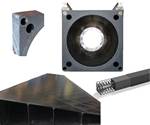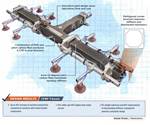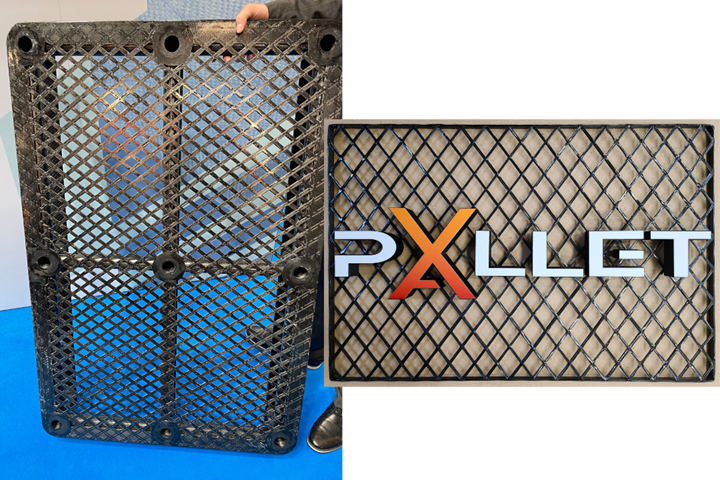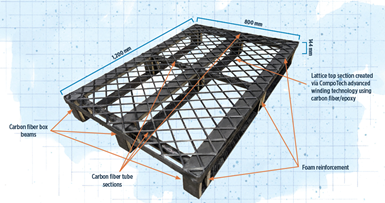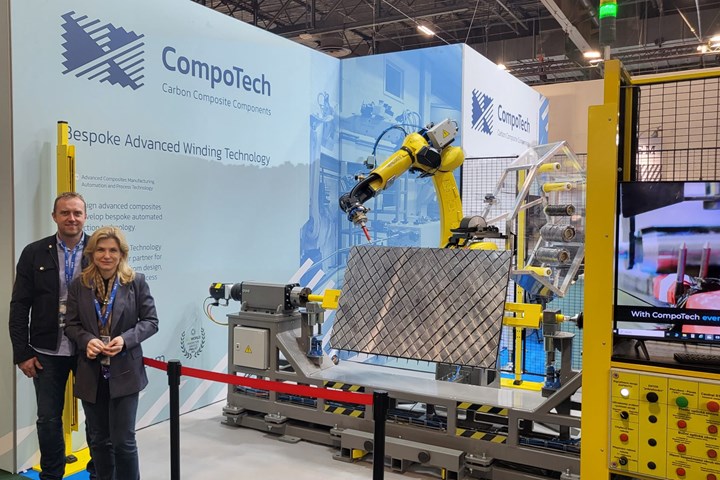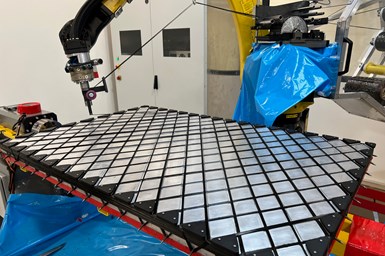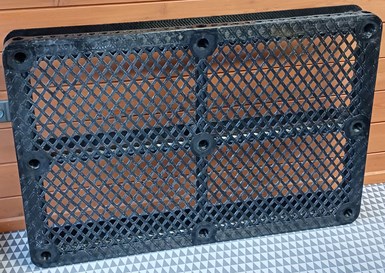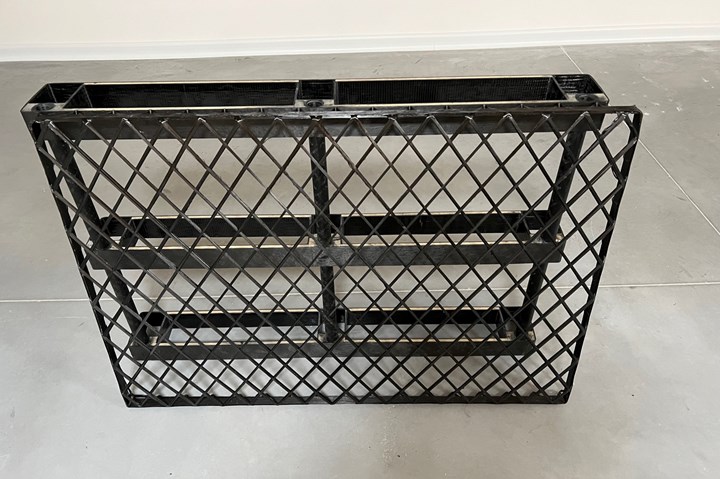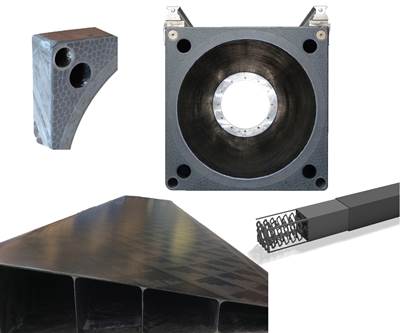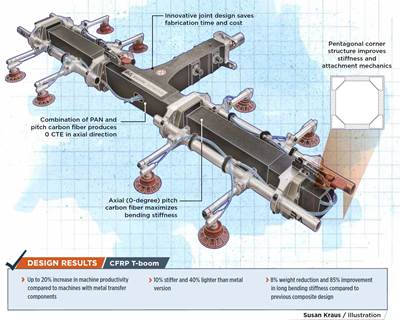Carbon fiber composite pallet revolutionizes freight industry
LOG Point Pallet fuses advanced materials with innovative design and manufacturing to improve supply chains worldwide.
PalletX uses carbon fiber-reinforced polymer (CFRP) and CompoTech's advanced winding technology to manufacture a lightweight, more durable, modular alternative to traditional shipping pallets. Shown here are the first-generation design (left) and final configuration (right) of the LOG Point Pallet. Source | PalletX
PalletX s.r.o. (Jihlava, Czech Republic) is a manufacturing startup that combines seasoned experience and innovative drive. Its goal? To manufacture carbon fiber-reinforced polymer (CFRP) composite shipping pallets that solve a host of issues in the material handling environment.
Carbon fiber isn’t the first option that comes to mind when you think about a shipping pallet. It doesn’t share much with the sporting goods, aerospace, automotive or high-performance products typical of CFRP end uses. Nonetheless, PalletX wanted to optimize its products for strength at the lightest weight possible.
Company founder Eva Kratochvílová, a longtime veteran of the logistics industry, saw a lighter weight, modular pallet design as an answer to the perennial challenges of logistics efficiency and sustainability — i.e., less fuel consumption to transport, and reduced waste because of its longer lasting qualities. With insights gained from a previous role, Kratochvílová’s experience with the robustness of carbon fiber in a hockey stick sparked the innovation behind the company’s first product, the LOG Point Pallet. “LOG is short for logistics,” explains Kratochvílová. “Manufacturers put their goods on the pallet, then it is transported to logistics centers and then to stores, factories, etc. It is a key part of goods moving swiftly and safely.”
Working with another Czech company, CompoTech (Sušice, Czechia), PalletX is using CFRP and advanced winding technology to redefine the physical and operational limits of traditional pallets. This pallet weighs only 7.5 kilograms, yet confidently carries 2 tons of goods in the rack and 4 tons on the floor. Thus, the LOG Point Pallet is not just a product but a paradigm shift — a solution that addresses the critical issues of pallet weight, dimensional stability, sanitation and durability head on. It also weaves digital intelligence into what is normally considered an analog product. PalletX promises a future where goods move more efficiently, and every pallet is a step toward a smarter, cleaner and more efficient future in material handling.
An idea whose time has come
Kratochvílová previously juggled the roles of commercial director and vice chairman of the board of directors for ICOM transport a.s. (Jihlava). With 1,800 employees and a fleet of 800 buses and 300 trucks under her watch, over her 20 years at the company she gained a deep understanding of the transportation and logistics industry. No matter what goods were being shipped, they all needed strong and reliable pallets.
Eva and her husband at CompoTech’s booth during JEC 2023, showcasing the bespoke advanced winding technology that aided in LOG Point Pallet’s development. Source | PalletX
“I like technological solutions in any field,” Kratochvílová says. “I enjoy watching and looking into how things work. What always astonishes me are simple, functional solutions.” The decisive moment for the LOG Point Pallet came unexpectedly, she explains. “My husband, an avid hockey player, damaged his carbon fiber stick during a game. The gears in my mind began to turn. Carbon fiber, known for its strength and lightness, seemed like the perfect material to innovate the traditional pallet.”
Realizing the potential, Kratochvílová knew it was time to seek expertise beyond her own. “I needed precise calculations, robust designs and automation software,” she adds. “That’s when I reached out to CompoTech. With their team of experts, we began the journey of transforming a simple idea into a robust carbon fiber composite shipping pallet.”
Lightweight materials, modular approach
Traditional shipping pallets — often made of wood or plastic, as well as metal for specific applications — have been a staple in the logistics industry for decades. However, these materials come with inherent limitations: Wood is heavy and susceptible to swelling, mold growth, insect infestations and decay, while plastic can lack durability, shatter due to impact or low temperatures, and is often not repairable.
Wood pallets are heavy, requiring more fuel to transport. They are also prone to rot (center) and insect infestation (left). Plastic pallets tend to crack or shatter (right). Source | PalletX
Kratochvílová recognized these challenges and envisioned a solution that would leverage the superior properties of carbon fiber composites. She explains, “We wanted to create something not just new, but revolutionary. The carbon fiber composite pallets are for me not only a light, durable version of a pallet, they are sustainable and offer a solution for information connectivity within the logistic processes.”
Finite element analysis of the LOG Point Pallet. Model geometry (left), FEA mesh (middle) and static load results (right). Source | CompoTech
From the start, the mission was clear: Design a pallet that meets stringent EuroPallet norms. Logistics processes are meticulously designed around these standards. But while keeping one eye on conformity, Kratochvílová saw an opportunity for innovation. “Imagine the pallet as a sophisticated Lego kit,” she says. “We build it using various shapes and components, each chosen for their technical and mechanical advantages. If damaged, they are easily repairable with replaceable parts or a system of premade patches and sleeves. When necessary, the pallet can be disassembled, repaired and then quickly reassembled.”
What about the cost?
Using carbon fiber in this application invariably raises questions about the higher cost versus wood or plastics. But Kratochvílová urges everyone to consider the cost through the lens of time and operating expenses. “We are confident that, when viewed holistically, our pallets are on par, or in some cases, more than cost-competitive due to their many advantages,” she notes.
CompoTech developed a six-axis placement and winding machine and software for lattice winding, shown here winding carbon fiber. Source | CompoTech
“For example, the reduced weight of our pallet increases the volume that can be transported,” she says. “Therefore, vehicles can carry more load for the same costs. Also, our lightweight pallets are easier for manual handling. They are similar in weight to carry-on baggage on an airplane.” They are also ideal for automated handling processes because, unlike traditional options, these composite pallets maintain a consistent weight and shape.
Kratochvílová notes that they can also feature unique identifiers such as EAN, QR or RFID codes used in industry for easy tracking. LOG Point Pallet products remain unaffected by temperature changes or humidity and their lifespans are much higher, exceeding 10 years.
For customers looking to leverage the full potential of the LOG Point Pallet, there’s also an option to add a small sensor box, transforming the pallet into a smart tracking tool. This enables monitoring for various conditions in real time, including tilt, impact, temperature, light exposure and even whether and where the goods are in motion. This high level of traceability and data collection turns the pallets into a digital component of supply chain management and optimization, which also increases their value.
High-performance manufacturing process
The manufacturing process for LOG Point Pallets uses the advanced filament winding and fiber placement techniques of partner CompoTech. “These allow PalletX to create complex, high-strength structures that enable the pallets to meet EuroPallet standards,” explains Humphrey Carter, head of business development for CompoTech.
The carbon fiber is first impregnated with epoxy resin, ensuring each strand is coated for maximum durability and strength. The wetted fiber is then wound into a lattice structure, forming the top of the pallet, which contributes to the pallet’s overall rigidity and stability.
Carter explains how this part of the design evolved. “With our advanced winding that we have developed over years, we already had a process called Integrated Loop Technology. This was our starting point for the first design — to create a pallet made from wound tubes connected with these continuous fiber loops.”
“However, under certain loading conditions, the flat skids were the weak point,” he continues. “So, we took a fresh approach, and in doing so, saw an opportunity to develop a new process within the capabilities of our control software [Schneg 2.0]. This gave us the ability to control the fiber placement in a way that was precise enough to create a lattice structure on a flat surface around an array of pins on the tool edge. Our team, with the help of ARC Robotics [a Fanuc robot integrator, Plzeň, Czech Republic] was able to develop this parametric control software that enabled the high-performance lattice structure for the LOG Point Pallet.”
In this process, tubes and rectangular sections are wound separately, cured and cut to length before being bonded together to create the supportive base structure. The lattice and base are then bonded into an integral unit. This method not only provides a consistent and high-quality pallet, but also enables a degree of customization and modularity not offered in traditional pallet manufacturing.
“For example, tubes or beams can be cut to different lengths to allow a longer pallet or higher payload,” says Carter. The resin used can also be customized for even higher chemical and fire resistance, for example, if a customer is transporting Li-ion batteries.
Setting a new standard
The collaboration between PalletX and CompoTech has produced a significant leap forward in pallet technology. “What sets this innovation apart is the partnership. We didn’t just create an automated production system and hand over the keys; we worked with PalletX to ensure that our technology meets their precise needs and enables the products they envision,” Carter explains.
Kratochvílová says that the LOG Point Pallets are currently in an early stage of production. She anticipates the start of commercialization in the third quarter of this year.
“With the LOG Point Pallet, we’re not just changing how goods are moved,” says Kratochvílová, “we’re changing the logistics landscape.” She envisions setting a new standard in the logistics industry. “Our journey has just begun, and the potential is limitless.”
About the Author
Michelle Maniscalco
Michelle Maniscalco is a Cleveland-based writer and consultant who began contributing to CompositesWorld magazine in 2024. She currently operates a content strategy consultancy (B2B Content Cure) that she founded in 2022, and will launch a content marketing educational business (UnPitchIt) in 2024. Prior to this, Maniscalco spent 14 years leading PR and content marketing efforts at polymer supplier Avient (formerly PolyOne). The first half of her career was spent as a senior editor covering materials and design, first at Penton Publishing’s Machine Design magazine, then later at Informa’s (formerly UBM Canon) Injection Molding Magazine.
Related Content
Otto Aviation launches Phantom 3500 business jet with all-composite airframe from Leonardo
Promising 60% less fuel burn and 90% less emissions using SAF, the super-laminar flow design with windowless fuselage will be built using RTM in Florida facility with certification slated for 2030.
Read MoreCombining multifunctional thermoplastic composites, additive manufacturing for next-gen airframe structures
The DOMMINIO project combines AFP with 3D printed gyroid cores, embedded SHM sensors and smart materials for induction-driven disassembly of parts at end of life.
Read MoreBladder-assisted compression molding derivative produces complex, autoclave-quality automotive parts
HP Composites’ AirPower technology enables high-rate CFRP roof production with 50% energy savings for the Maserati MC20.
Read MorePlant tour: Aernnova Composites, Toledo and Illescas, Spain
RTM and ATL/AFP high-rate production sites feature this composites and engineering leader’s continued push for excellence and innovation for future airframes.
Read MoreRead Next
Innovating composites to open new markets
From machine tools to trainer jets, CompoTech develops new design and process solutions.
Read MoreCompoTech: Designing and Supplying Turnkey Composites Technologies
At JEC World 2023, CompoTech showcased its automated fiber winding and laying technology capabilities, highlighting the company’s latest custom-built, automated fiber winding machine, with fiber placement using a FANUC six-axis robot.
Read MoreComposite T-boom accelerates industrial automation
A manufacturing method that integrates filament winding with axil winding of 0-degree fibers opens new design options in industrial automated equipment.
Read More
